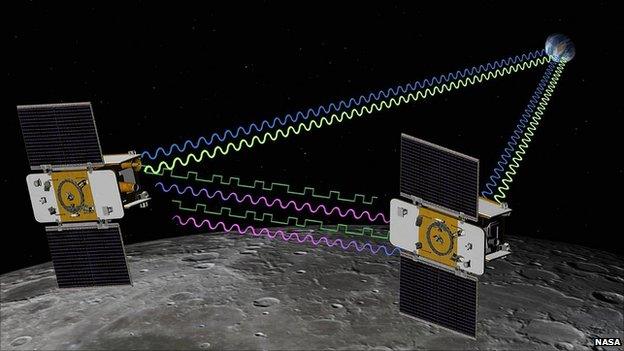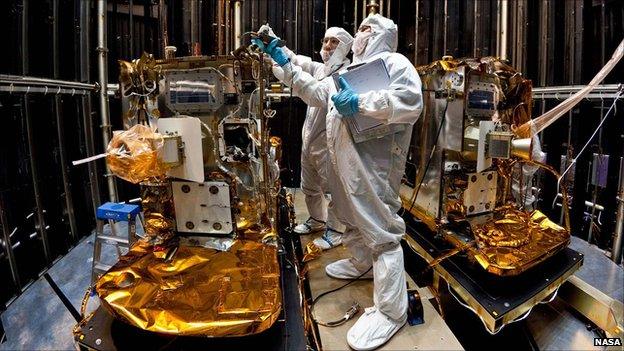Nasa's Grail twins to make gravity maps
- Published

The Grail twins will make their measurements by executing a carefully calibrated pursuit in orbit
The latest spacecraft to go to the Moon have launched from Florida.
Nasa is sending twin probes called Grail, external to map tiny variations in the pull of gravity around the lunar body.
The information should give scientists fresh insight into the internal structure of Earth's satellite.
This will help explain many mysteries, such as why the farside of the Moon looks so different from that of the nearside with its great swathe of dark volcanic plains, or maria.
The data also will be an invaluable navigation tool for future exploration, enabling other spacecraft to make more precise landings.
A Delta rocket sent the Grail twins on their way. Its launch from the Cape Canaveral Air Force Station occurred at 09:08 EDT (13:08 GMT; 14:08 BST).
The journey to the Moon is a slow cruise, however. The duo is not expected to enter into orbit until the turn of the year.
'Super-lens' on gravity
Scientists already have some lunar gravity maps. Much of this information was built up by tracking small perturbations in the orbits of previous spacecraft as they circled the Moon. But the maps are very coarse, especially for the farside.
The rocket launches from Cape Canaveral Air Force Station in Florida
"The improvement that Grail will have for the gravity field on the nearside is a factor of 100 better than we have right now, and on the farside it is a factor of 1,000," said Grail programme scientist Dr Robert Fogel.
"Imagine trying to see something microscopic with your own eyes and then putting a lens in front of them that has 100 times power or 1,000 times power - it becomes a different world; and that's what we'll get with Grail," he told BBC News.
Grail is an acronym for Gravity Recovery and Internal Laboratory. Its mission is very similar in design to that of a Nasa/German Space Agency venture called Grace that is currently mapping variations in gravity across the Earth.
These differences are the result of an uneven distribution of mass. Obvious examples at the Moon's surface include big mountain ranges or deep impact basins, but even inside the lunar body the rock will be arranged in an irregular fashion, with some regions being more dense than others. All this will have a subtle influence on the pull of gravity sensed by over-flying spacecraft.
The Grail twins will make their measurements by executing a carefully calibrated pursuit just 55km above the surface.
As the lead spacecraft flies through the uneven gravity field, it will experience a small acceleration or deceleration. The second spacecraft, following some 200km behind, will detect this disturbance as a very slight change in the separation between the pair.
"We can measure the distance between these two spacecraft to less than the size of a red blood cell in humans - a change of a few tens of a micron per second in the velocity of these two spacecraft," explained Dr Maria Zuber, Grail's principal investigator, external from the Massachusetts Institute of Technology.
'Other moon'
When the gravity map is combined with comparable-resolution topographical information showing the surface highs and lows, scientists should be able to deduce the Moon's probable internal structure and composition. This is fundamental knowledge that will play into theories of how the lunar body formed and how it has evolved over time.
One puzzle to be addressed concerns those dark maria. Why, in the early history of the Moon, did impact basins on the nearside become flooded with basalt when deeper regions of the farside did not? The new gravity map will be used to test competing theories.
Another fascinating idea to emerge recently that will come under scrutiny from the Grail "microscope" is the suggestion that the highlands on the farside were formed as a result of a low-velocity impact by a second, much smaller moon.
A research team published a paper in the journal Nature last month, external that showed how such an impact could have added material to the crust on the far hemisphere.
"When I first saw the paper I thought it was outlandish, but as I read the paper I realised that the simulations that were done were very well thought out, and they made specific, testable predictions that could be addressed by studying data that will be obtained with Grail," said Dr Zuber.
The type of ranging measurements made by missions such as Grail and Grace require very precise timing systems.
For the Grace twins, the timing reference is provided by global positioning satellites (GPS).
These satellites are not present at the Moon, and so each of the Grail probes carries high-performance oscillators.
This innovation means a Grail-like mission could now, in theory, be sent anywhere in the Solar System to study the gravity of other planetary bodies.

The Grail twins borrow technology developed for the Grace gravity mission at Earth
- Published6 September 2011
- Published3 August 2011
- Published31 March 2011
- Published5 July 2010